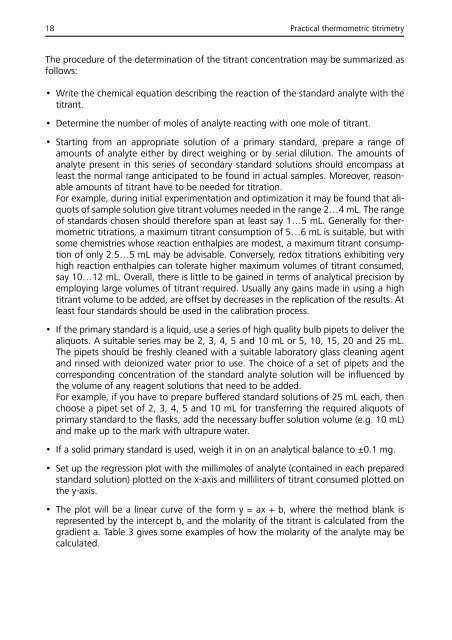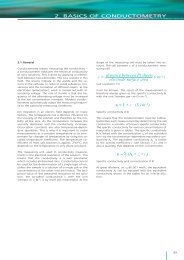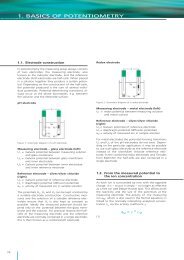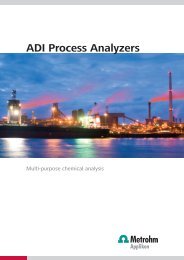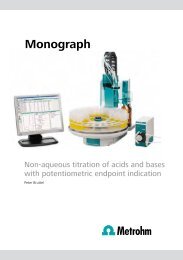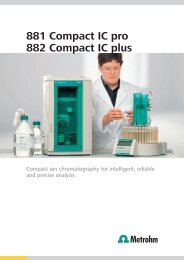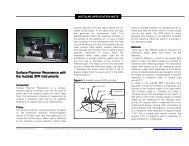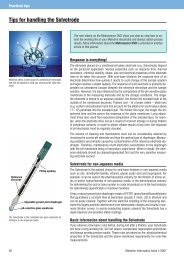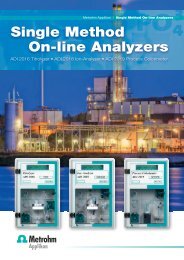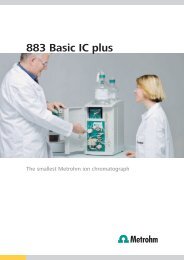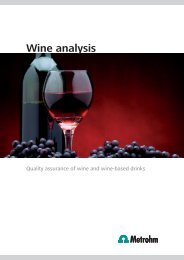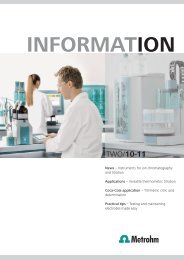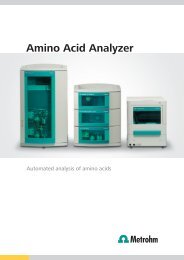Monograph - Metrohm
Monograph - Metrohm
Monograph - Metrohm
Create successful ePaper yourself
Turn your PDF publications into a flip-book with our unique Google optimized e-Paper software.
18 Practical thermometric titrimetry<br />
The procedure of the determination of the titrant concentration may be summarized as<br />
follows:<br />
• Write the chemical equation describing the reaction of the standard analyte with the<br />
titrant.<br />
• Determine the number of moles of analyte reacting with one mole of titrant.<br />
• Starting from an appropriate solution of a primary standard, prepare a range of<br />
amounts of analyte either by direct weighing or by serial dilution. The amounts of<br />
analyte present in this series of secondary standard solutions should encompass at<br />
least the normal range anticipated to be found in actual samples. Moreover, reasonable<br />
amounts of titrant have to be needed for titration.<br />
For example, during initial experimentation and optimization it may be found that aliquots<br />
of sample solution give titrant volumes needed in the range 2…4 mL. The range<br />
of standards chosen should therefore span at least say 1…5 mL. Generally for thermometric<br />
titrations, a maximum titrant consumption of 5…6 mL is suitable, but with<br />
some chemistries whose reaction enthalpies are modest, a maximum titrant consumption<br />
of only 2.5…5 mL may be advisable. Conversely, redox titrations exhibiting very<br />
high reaction enthalpies can tolerate higher maximum volumes of titrant consumed,<br />
say 10…12 mL. Overall, there is little to be gained in terms of analytical precision by<br />
employing large volumes of titrant required. Usually any gains made in using a high<br />
titrant volume to be added, are offset by decreases in the replication of the results. At<br />
least four standards should be used in the calibration process.<br />
• If the primary standard is a liquid, use a series of high quality bulb pipets to deliver the<br />
aliquots. A suitable series may be 2, 3, 4, 5 and 10 mL or 5, 10, 15, 20 and 25 mL.<br />
The pipets should be freshly cleaned with a suitable laboratory glass cleaning agent<br />
and rinsed with deionized water prior to use. The choice of a set of pipets and the<br />
corresponding concentration of the standard analyte solution will be influenced by<br />
the volume of any reagent solutions that need to be added.<br />
For example, if you have to prepare buffered standard solutions of 25 mL each, then<br />
choose a pipet set of 2, 3, 4, 5 and 10 mL for transferring the required aliquots of<br />
primary standard to the flasks, add the necessary buffer solution volume (e.g. 10 mL)<br />
and make up to the mark with ultrapure water.<br />
• If a solid primary standard is used, weigh it in on an analytical balance to ±0.1 mg.<br />
• Set up the regression plot with the millimoles of analyte (contained in each prepared<br />
standard solution) plotted on the x-axis and milliliters of titrant consumed plotted on<br />
the y-axis.<br />
• The plot will be a linear curve of the form y = ax + b, where the method blank is<br />
represented by the intercept b, and the molarity of the titrant is calculated from the<br />
gradient a. Table 3 gives some examples of how the molarity of the analyte may be<br />
calculated.


